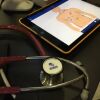Six million children are transported by ambulance each year. Taking care of these patients can be stressful and present unique challenges for EMS providers.
We just don’t treat children every day. We also get a limited amount of exposure to pediatrics during training. The drug doses are different, and often the equipment required is different than what we use on adults.
For these reasons specialized pediatric kits were developed to keep pediatric equipment all together in one location. The first of these was the Broselow Pediatric System from Armstrong Medical.
The Broselow System was developed in conjunction with the Broselow Pediatric Emergency Tape.
The Tape is a simple, color-coded length based chart. It provides the appropriate drug dosing, ET tube size, and other essential information printed on a very easy to use reference chart.
To use it, you just unfold the tape and determine the color block equal to the child’s length. If, for example, the color block is green, you just grab the green pouch in the Kit. Everything you will need for that patient will be in the pouch.
It works great, but has a couple of minor limitations in EMS. First, it requires a lot of redundant stocking, which increases weight, bulk and cost.
Second, to access the pouches is a bit challenging in a limited space environment. All of the pouches are mounted on a long Velcro panel that takes up a lot of space to open it. In a hospital it works great, you can hang the modules all up on a wall.
For these reasons, EMS providers came up with some different solutions. Most today use the Tape or some other Pediatric reference like the Pedi-Wheel. But instead of using the big Broselow Kit, they use a different case.
One of the first popular alternative solutions was the Thomas Aeromed Advanced Pack. This more compact deployment option also features color-coded modules, but it is smaller and more convenient to use and store. There are several similar kits available from others sources.
A much more recent Thomas EMS Kit is their Thomas Pediatric Pack. This sophisticated deployment option offers modules with printed weight ranges. It’s fast to find the right equipment for your patient and it is easy to use.
Eight separate high visibility removable pouches are designed to treat all pediatric patients up to 36kg. Each pouch is designed to accommodate all of the medical equipment necessary to treat a patient in each specified weight range.
All non-weight specific pediatric equipment can be stored inside the main inside chamber, or on the interior fold out flap. The fold out flap includes a neo-natal kit, and also features an area to display all quick reference material.
One much smaller kit often used for pediatrics was the Pacific Compact Kit. Today a bag of similar design, called the Pediatric Advantage, is available from EMP. It is actually a copy of a bag dating way back to WWII. It is a compact kit that works particularly well for basic level providers.
Another option is the Pediatric ALS Attack Pack from LA Rescue. It features 8 zippered colored pouches that can be used with the CrashCard Pediatric Resuscitation System.
The removable pouches are perfect for organizing pediatric equipment based on the child’s age. It also features five external zippered compartments and one large exterior pouch for other pediatric supplies.
One new pediatric kit is the Handtevy Pediatric Box, which should be available this spring. Instead of a bag, this pediatric kit is built into a rugged hard case.
The modules are labeled based on age not length or weight. This system is so simple that you can determine drug volumes and age appropriate equipment within seconds.
The good news for EMS is that today there are more options for pediatric equipment deployment than ever before. The other good news is many of these options have become much more affordable.
Being able to quickly find everything you need for pediatric care in one location saves time and lives.
Even more exciting is that some civic groups have provided funds for the purchase of pediatric kits. Both Wisconsin and Oregon are just two states where grants have helped EMS acquire the pediatric solutions they need.













